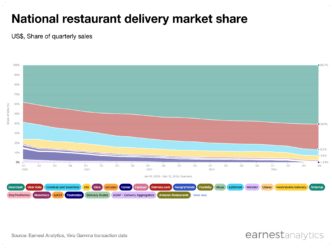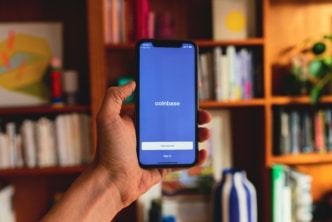Who’s ahead in the race between Grubhub, Uber Eats and DoorDash? It depends on your zip code.
Over the past few years, third-party restaurant delivery services like GrubHub-Seamless and Uber Eats have gained a major foothold in the wallets of busy urbanites. If you live in a large city like New York, San Francisco, or Washington, D.C., chances are you have used at least one of these services to order lunch or dinner. More recently, third-party delivery platforms have been setting their sights on smaller cities and suburban markets. It would appear that hungry consumers aren’t the only ones with insatiable appetites.
We analyzed the purchase history of millions of anonymous U.S. consumers to better understand what regional and behavioral trends continue to contribute to the boom in third-party restaurant delivery services. Netflix binges may well be a factor, but that’s a question for another post.
Key Takeaways
- The third-party restaurant delivery industry continues to experience explosive growth
- GrubHub-Seamless dominates in large urban centers of the East Coast, like New York and Boston, while Uber Eats is catching up in emerging markets
- Virginia Beach, San Antonio and Baltimore are among the fastest growing markets for third-party restaurant delivery services
- Grubhub-Seamless orders per customer have been declining, while Uber Eats and DoorDash see order growth
A Huge Appetite for Third-Party Restaurant Delivery
The rise of third-party restaurant delivery companies like Grubhub-Seamless, DoorDash and Uber Eats is hard to ignore. Walk a few city blocks and you will likely have to dodge several delivery people on electric bikes. According to Earnest Analytics (FKA Earnest Research) data, third-party delivery revenue has been growing over 50% annually from 2015 through 2018. To put that in context in the restaurant space, only Chick-fil-A, on track to become the 3rd largest restaurant chain in America, comes close to this type of growth at 16%, while McDonald’s has been growing at a rate of 5% annually in the same time period.

Small Cities, Big Growth
To analyze how the top restaurant delivery services are performing in different markets, we categorized various CBSAs* as mature or emerging markets based on the growth of third-party restaurant delivery services in these areas. We defined mature markets as the large metropolitan CBSAs of New York, Los Angeles, San Francisco, Chicago, Philadelphia, D.C. and Boston, which were the first to adopt online food delivery. We categorized all CBSAs excluding the aforementioned mature markets as emerging markets.
Our data shows that online restaurant delivery has experienced considerable growth across both mature and emerging markets, with Virginia Beach, San Antonio and Baltimore leading for highest year-over-year growth between 2018 and 2019. In these areas, third-party restaurant delivery services revenue more than doubled, proving that the food delivery industry continues to grow as food-on-demand becomes the new normal.
*CBSA = Core-based statistical area

The Playing Field Evens Out in Emerging Markets
While regional differences abound when it comes to delivery preferences and availability of services, our data showed some commonalities. Residents of mature markets on the East Coast like New York and Boston overwhelmingly turn to Grubhub-Seamless for their takeout needs, giving the longstanding delivery player 71% market share in the Big Apple and 51% in Beantown in 4Q 2018. It may be worth noting that Grubhub-Seamless had a considerable head start on the competition. Before merging in 2013, each had already been around for years, and Grubhub’s original, now humble-seeming mission was just to render paper menus obsolete.

Meanwhile, residents of San Antonio are split in their loyalty to both Uber Eats and DoorDash, while almost half of all Atlantans use Uber Eats for their delivery and takeout needs.
Grubhub-Seamless Orders Per Customer Decline
On average, Grubhub-Seamless customers order more frequently on the platform, but orders per customer have been declining over the last two quarters, and are 6.8% lower in Q4 2018 than in the previous year. This trend reflects the leveling out of the national playing field, as Grubhub-Seamless expands outside its core markets and competes in emerging cities, where Uber Eats and DoorDash continue to pick up share.

As the competition heats up between the leading delivery players, some are exploring partnerships with popular QSR brands. Uber Eats partnered with McDonald’s in 2017, while Grubhub-Seamless buddied up with Yum! Brands in early 2018.
Will Uber Eats continue its growth trajectory? Will Grubhub-Seamless continue to gain share with new initiatives like Dunkin’ coffee delivery, or will a new player enter the field and win the hearts and stomachs of hungry non-chefs?
Subscribe for insights to get the latest trends and takeaways in third-party restaurant delivery.











